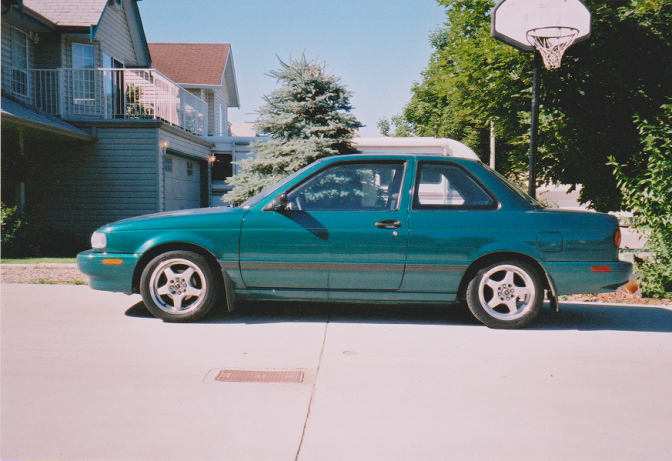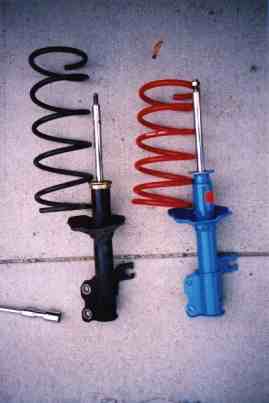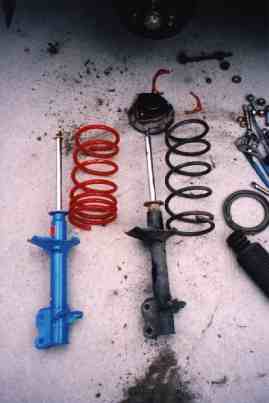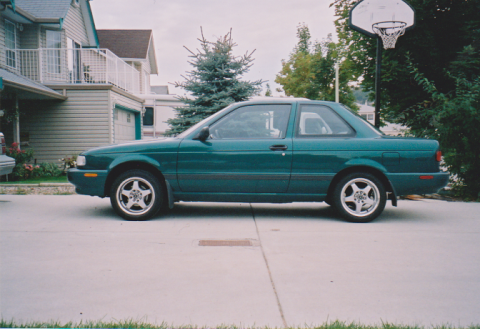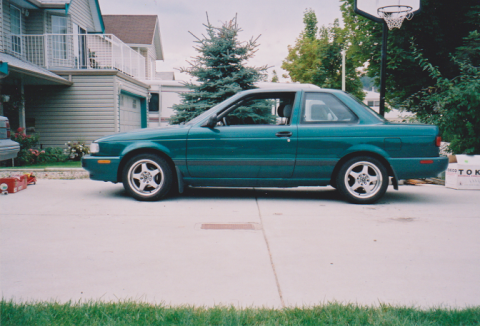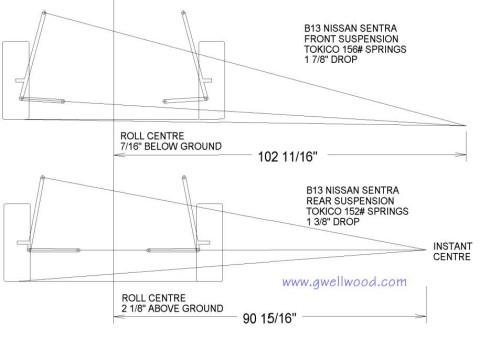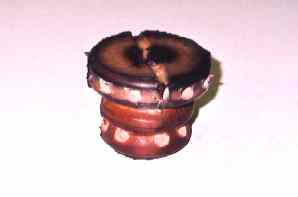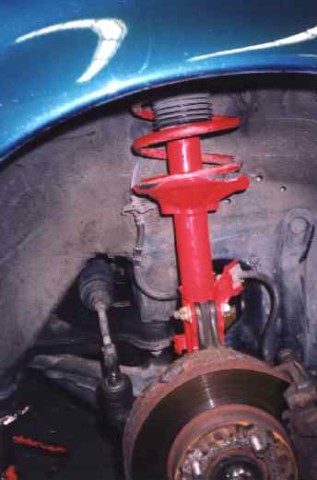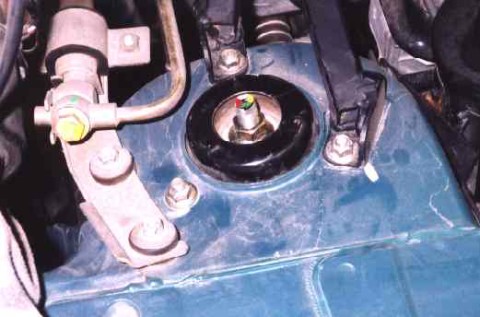[ Start ] [ Wheels & Tires ] [Bushings ] [ Springs & Struts ] [ Sway Bars ] [ Alignment ] [ Drivetrain ] [ Miscellaneous ] [ Racing ]
OEM Assessment
Nissan chose a spring for the B13 Sentra in accordance for the intended usage of the car: non-performance. The suspension is predictable, safe, comfy and quiet.
Having come from the well-prepared H/Stock Heinous Honda, this suspension was far removed from acceptable to my liking. I found it far too soft. It was floaty, wallowing, imprecise and uncontrolled. There was more body roll than an storm-tossed ship, the car handled like the body was attached to the chassis through a ball-and-socket arrangement. I hated it.
Lowering Springs
|
Aftermarket Handling Kit
I chose the Tokico Advanced Handling Kit (#HPK225) for the following reasons:
Tokico
|
Tokico’s Advanced Handling Suspension Kit comes complete with front and rear springs and struts, and minimal instructions. The specifications indicate that the kit will lower the Sentra 1.250″ front and rear.
Compared to changing bushings, this is really easy. For each strut, be sure to disconnect the brake cable clip, then undo and remove the strut as an assembly.
I compressed the springs with the coil spring compressor, removed the springs, cut the front bump stops in half, left the rear bump stops uncut, and assembled the Tokico springs and struts with the Sentra hardware. Be sure to use the Sentra dust covers, as you void the strut warranty if they are not used.
Notice the markings on the top spring perch (not shown) – the triangle should be pointing inline with the lower strut mount, or the spring will not be mounted “square.”
The Tokico spring’s free length is just short enough to be installed without a spring compressor, but make sure they are properly seated. Re-use the Nissan rubber spring insulators. The springs are labelled for front and rear.
The back seat must be removed to undo the top mount for the rear struts. This is super easy. On either side of the front of the seat bottom cushion, there are two plastic sprung pull-clips that free the bottom cushion from the car. The seat weighs virtually nothing, so remove it from the vehicle.
The seat-back can then be removed by removing two screws at the bottom of the cushion near the side panels, and then pulling the seat-back up. This too weighs nothing. This will reveal the three nuts holding the upper strut mount. A 1/4″ drive 12mm socket and ratchet work well to remove these fasteners. You will notice that there is a fair bit of material supporting the strut towers. I don’t think adding a rear strut tower bar would make a significant difference.
In installation, I installed the front struts to the steering knuckle first, and tried to “fake” some negative camber by taking up any slack in the mounting holes. This was only able to give me -1° camber, which is insufficient for autocross. On the street, I doubt the camber will cause excessive tire wear. The vehicle MUST be aligned after installing the springs and struts. The toe setting will be WAY out, and toe destroys tires.
The swap took me less than four hours, with no difficulties (other than trying to pry the rear spindles into the struts since the polyurethane bushings had no compliance).
Many people have complained online about the harsh ride of the Tokico struts. The ride is not uncomfortable, although certainly “stiffer” than the original struts and springs. The bushings made a more dramatic reduction in ride quality than the spring kit did. The handling is more sure and confidence inspiring, and the car feels much more tossable. The springs did not eliminate body roll, and in fact the change in suspension geometry due to lowering can sometimes increase body roll. Adding aftermarket sway bars will complete the package nicely.
I measured the car before and after, and found that the kit lowered the car 1.875″ in front, and 0.625″ in back (The mathematically astute among you will note that the front/rear average is 1.250″). The fender gap is now exactly equal at all four wheelwells, and the distance from hub centreline to each fender edge is 13″. (At first I thought the front had dropped too low, but later I learned that the Canadian B13’s made in Mexico are approximately 1/2″ taller than their US counterparts. Perhaps the Sentra was lowered correctly in the front after all, and that the rear just didn’t get lowered enough….)
An excellent writeup can be found here: SE-R.net Tokico Kit Page.
8 months after I installed these springs and struts, I had become disappointed with the kit. For a street setup, it is absolutely fine. In competition however….
Tokico Handing Kit Assessment
|
These problems warranted further study.
Centre of Gravity and Roll Centres
The Sentra was experiencing excessive corner entry oversteer. One of the causes of excessive corner-entry oversteer is excessive chassis rake. I had 1.25″ of chassis rake on the car with the Tokico springs.
Imagine you and buddy running through a corn field carrying a 4×8 sheet of plywood on edge. Your buddy is in front, holding his end of the sheet in the middle, and you’re running along behind, holding it ONLY by the bottom edge. As your buddy turns sharp corners to follow the crop circles, he remains controlled, but you find that the top of the sheet wants to fall over since you are only holding it by the bottom. This is kind of like what the Sentra as doing.
The font of the car would turn in fine, but because the rear was so comparatively tall the rear always wanted to break loose and come around on you. There were only two solutions to the problem:
Excessive Chassis Rake Solutions
|
Now, I had spoken with Tokico via phone on a number of occasions confirming that I had the right springs for the car, that the right springs were in the right end of the car, and that the springs were manufactured to specification. Oddly enough, everything checked out ok. After these numerous phone calls and faxes, Tokico was either unable or unwilling to help me.
I explored the possibility of raising the front of the car, and even designed a set of spring shims to raise the front about 1/2″, but raising the Centre of Gravity (CG) is generally counter-productive for performance.
I also received an email from a fellow who had a similar problem with his Sentra when he installed coilovers. He found that when the rear control arms were above horizontal, the car had severe oversteer, and that the car handled better when the rear control arms were perfectly horizontal.
So, I tossed the offer out to my Mechanics 10 students to learn how to lower a car. They went for it, and we took the rear springs out and cut 1.5 coils off the rear springs. This lowered the rear approximately 0.75″ more, producing a 0.5″ chassis rake from the original 1.25″. The rear control arms are now 1/32″ below horizontal.
With the rear CG reduced, the car became much more predictable and neutral handling. It could be easily pursuaded into oversteer, and corrected from understeer with throttle modulation or trail braking.
One problem I encountered with the car this low, is my rear 13×7″ 205/60R13 Race Tires would hit the fenders, resulting in violent, unpredictable and extreme oversteer. This was remedied by rolling the fenders with a 2 1/4″ exhaust pipe and some help moving the car back and forth. There is about 1/16″ clearance between the rear tire sidewall and the fender edge now.
I then measured the entire suspension, and determined the roll centres of the car at this ride height.
The roll centre is the fulcrum about which the tires apply their tractional force to the body. The roll centre is determined by suspension angles. When a car is lowered, the resultant changes to the suspension geometry produce a lower roll centre. The greater the distance between the centre of gravity (CG) and the roll centre (RC), the greater the load the body roll applies to the springs (that is, the body will want to roll more).
Think of a lever, where one end is the fulcrum, and one end has the load. The farther away the load is from the fulcrum, the less load is required to do the same work. Therefore, the farther away the CG is from the RC, the more work is done since the load remains unchanged. This helped me understand why the car was bottoming so much in turns.
There were three solutions to preventing this bottoming:
Chassis Bottoming Solutions
|
We can scratch raising the chassis, as that is changing things in the wrong direction.
Spring Rates
Nissan did not bless the Sentra with a large suspension travel. Sadly, this becomes a large issue when preparing a Sentra for competition. The general consensus is to run either 300/200lb-in coilovers or custom made springs. This allows a 1″ drop and keeps the car off the bump stops. At the present I am not quite willing to go that route on my Sentra. To explain, let’s look at the purpose of springs:
Purpose of the Spring
|
The best springs to achieve these goals is the stock, factory springs. Unfortunately, the handling can be greatly improved by bringing the car closer to the ground and lowering the centre of gravity. This improves handling significantly.
As we lower a car, the suspension travel is reduced – then when we hit a bump, there is no room for the suspension to absorb the bump and the car bottoms out on the suspension components. This is particularly harmful in that when the suspension bottoms, the effective spring rate becomes infinite, causing the bottomed suspension to lose traction. This can result in snap-oversteer/understeer, depending on which end of the car bottomed.
It is therefore important to stiffen the springs at least enough that the new lowered suspension would theoretically bottom with the same force as the OEM suspension.
| Front suspension travel: | Front spring rate: | Load at full bump: | |
| OEM height Bumpstops 1.50″ |
2.00″ | 112 lbs/in | (112 x 2)
= 224 lbs
|
| Lowered 1.25″ Bumpstops 1.50″ |
(2.00 – 1.25)= 0.75″ | (224)/(0.75)
= 298 lbs/in
|
224 lbs |
| Lowered 1.25″ Bumpstops 0.75″ |
(2.00 – 1.25 + 0.75)= 1.50″ | (224)/(1.50)
= 149 lbs/in
|
224 lbs |
I’m showing calculations here based on two different setups: un-cut bumpstops (OEM length 1.50″), and cut bumpstops (0.75″). It is common practice in lowering a car to cut the bumpstops in half so as to regain some supension travel. In fact, the majority of aftermarket spring manufacturers market spring rates in line with these figures, assuming you cut your bump stops in half. The Tokico front springs I have are 156 lbs-in., whereas the popular Eibach spring is 148.5 lbs-in.!
What these calculations do not take into account is the increased lateral loading due to the lowered roll centre (See above in Centre of Gravity and Roll Centres). I have not yet found calculations to compensate for this.
Keeping in mind the purpose of the spring, there are two general philosophies regarding spring rates:
Spring Rate Philosophies
|
The first philosophy makes the most sense to me, as it still complies with the purpose of the spring. This also favours the “dual-purpose” nature of my vehicle goals.
There are risks involved in going to a stiffer spring.
High Spring Rate Problems
|
Herb Adams (1993) writes regarding spring rates for street cars:
“All stiffer springs do is make the car have a stiff ride. They have no capability to make a significant improvement in handling. As long as the springs on a car are stiff enough to keep the car from bottoming out, they are adequate. If a car is lowered, a slight increase in spring rate can be used to compensate for the reduced travel.”(“Chassis Engineering” p.32)
See Addendum for an updated study on 300/200 spring rates!
Weighing all the options, I felt that the best compromise might be to run the Tokico springs unless I was unable to extract reasonable performance from them. This didn’t take long.
I have, however, gathered the following information on the available aftermarket springs for the B13 Sentra:
| OEM-Style Spring Rates | ||||
| Front Rate | Rear Rate | Front Drop | Rear Drop | |
| Eibach Pro Kit | 148.5 | 68.5-159.9 | 1.20 | 1.20″ |
| Eibach Sportline | 148.5 | 90.5-142.8 | 1.60 | 1.50″ |
| Hyperco Gen1 | 110-180 | 75-174 | 1.40 | 1.25″ |
| Hyperco Gen2 | 110-290 | 75-200 | 1.00 | 1.00″ |
| Progress Group | 165 | 140 | 1.70 | 1.70″ |
| Suspension Techniques | 133-175 | 91-150 | 1.50 | 1.50″ |
| Tokico | 156 | 152 | 1.25 | 1.25″ |
| GA16DE Sentra E | 112 | 101 | ||
| GA16DE Sentra XE, GXE | 112 | 90 | ||
| SR20DE Sentra SE-R | 123 | 112 | ||
Suspension Frequencies
Many chassis designers use suspension frequencies as a way of determining spring rates for a particular vehicle. This is the natural oscillation of the suspension over bumps, taking into account the spring rates and motion ratios of the suspension. Frequency is measured in cycles per minute (CPM) or in cycles per second (CPS).
The frequency is determined by measuring and calculating the motion ratios of the entire suspension to determine how much of the actual spring rate is applied to the wheel (these are lever arm ratios). A wheel rate is determined (that is, the effective spring rate at the wheel), and compared to the actual sprung weight of the car. There are a multitude of books on the subject, so I won’t bore you with details here. What is interesting is how this information is used.
Generally speaking, different suspension frequencies have different ride quality characteristics:
| Suspension Frequencies OEM – 75 cpm (1.25 cps) Sporty – 90 cpm (1.50 cps) Uncomfortable – 120 cpm (2.00 cps) |
Using the figures from finding the instant and roll centres, I calculated the suspension frequencies on the B13 Sentra:
| Suspension Frequencies OEM Front – 112lb/in – 76cpm (1.27cps) OEM Rear – 101lb/in. – 92cpm (1.45cps) Tokico Front – 156lb/in – 90cpm (1.50cps) Tokico Rear – 152lb/in – 113cpm (1.89cps) Coilover Front – 300lb/in – 124cpm (2.07cps) Coilover Rear – 200lb/in – 130cpm (2.17cps) |
This table assumes that the rear springs are linear rate, where in fact the rear springs may be somewhat progressive, thus the rear frequencies would be artificially inflated. Springs used in coilover kits are almost always linear rates.
Seeing the suspension frequencies with my existing springs led me to believe that I should increase the travel, as the current spring rate should be more than adequate. In comparing my Sentra’s setup against a fellow competitor’s NX2000 with Ground-Control 350/300lb-in coilovers, he says my car is much better at the slaloms, possibly because of the softer spring.
See Addendum for an updated study on 300/200 spring rates!
Suspension Travel
Since I decided to keep my current springs, this led me to a study on increasing suspension travel. As mentioned, the Sentra does not have much travel. There is only one manufacturer who offers shortened struts for the B13 Sentra.
Motivational Engineering offers shortened OEM style struts, as well as threaded struts for coilovers, using a shortened Koni insert. They list for $235USD a piece (2002) for the OEM style strut housing.
Purchasing these, although ideal, would get expensive for me, and would necessitate upgrading the rear struts to Koni as well, as the dampening characteristics between the Tokico’s and the Koni’s are QUITE different. The Koni’s are arguably the best and most competitive you can buy.
I contacted Koni to see if they had any inserts that were shorter than the standard Sentra ones, with the hopes that I could shorten my own struts. They didn’t stock any, but they did mention that they could shorten their existing strut inserts as well as (on request) re-valve the insert and even convert them to external-adjustability. All this comes at a (hefty) price, and if racing put food on the table, I might have considered it.
This led me to investigate altering the bumpstops to become a more integrated part of the suspension.
Bumpstops
Following a discussion on Miataforum.com lead by a fellow competitor, I began to think that I could get around the bottoming issue by modifying my existing bumpstops.
As I mentioned earlier, I had cut my bumpstops in half to gain 0.75″ suspension travel. The bumpstop on the Sentra is microcellular foam, and is relatively soft. It is designed to add additional “spring rate” when it is compressed. The added “rate” increases the more the bumpstop is compressed. Cutting the bumpstop, although increasing travel, removed much of the “progressive” nature of the bumpstop, thus making bottoming a more abrupt event than desired, thereby upsetting the handling of the car.
My theory was to run full length, softer bumpstops to allow the suspension to contact the bumpstops earlier, but to permit a more gradual increase in spring rate as the bumpstop compresses.
To do this, I reinstalled the cut portions from the original bumpstops, but driller twentyfour 1/4″ holes around the perimeter of the bumpstop (some around the base, the middle and the top). Removing material in this way allowed the bumpstop to compress much more easily than before, but since the stop was effectively longer the end result was a softer bottoming, just as I had hoped!
I perfomed this modification at the same time as installed new KYB AGX struts, as I was very unhappy with the performance of the Tokico Blue struts.
Damping Characteristics
Once you have your suspension sorted out and your desired spring rates chosen, you need to damp the movement of the springs. Some shock/strut manufacturers have different approaches than others on how to accomplish this task.
Struts are merely a special type of shock absorber. Shocks are more correctly called Dampers in England, as they are there to damp the oscillation of the springs. A stiffer spring, oscillating at a higher suspension freqnecy, requires more force to control it – a stiffer shock is in order. Installing stiffer springs without upgrading the shocks is a false economy – the OEM shocks are not designed to keep up with such high suspension frequencies, and are therefore insufficient in damping the higher spring rate. The car then becomes very bouncy, and the shocks wear out prematurely.
Following testing at the Velocity Car Development School as well as my own observations and assessments, it was determined that the Tokico struts were very underdampened. A call to Tokico revealed that warranty for the struts would be a pain – it was mid-season, I needed better struts, and the warranty people suggested I buy a new set of struts, send the old ones in to Tokico, and then they would refund me the purchase when the old ones were warrantied. Oh yeah, like I’m going to buy Tokico Blues again.
I decided to purchase KYB AGX struts. They are single adjustable (compression and rebound) and stiff enough to damp 300lb-in springs or more if need be. These struts seem to be the strut de’jour among the Sentra crowd. From a competition perspective, having rebound-only adjustment (like Koni struts) is far better than having both simultaniously adjustable. From a practicality persepctive, the Koni struts did not meet my purpose.
One of the advantages of the KYB AGX struts is the external adjustment. Since I drive in “real” winters, I need to be able to de-tune the suspension to handle the icy, choppy winter conditions. I am not willing to swap suspensions twice a year to have a decent winter car and a decent autocross car. I also liked the “tunability” that the Tokico Illumina’s gave me on the Heinous Honda. However, sometimes the compromises you make for dual-purpose car make the car uncompetitive in both arenas: it is neither comfortable nor quick.
It took a number of months for the KYB AGX‘s to come in – the rear struts were backordered across Noth America, and had to come straight from Japan.
| KYB AGX Part Numbers #733014/5 (L/R F) #732001/2 (L/R R) |
Once the struts came in, I changed all four of them after work in about one hour with the help of a friend and some air tools. The fronts have four settings, while the rear’s have eight settings. I set them to the lowest setting initially. Driving out of the shop, I imediately felt the front were too soft, so I turned both front and rear up to setting two, later upping the rear to four.
This gave a ride quality similar to the Tokicos as far as harshness. However, the harshness was very different feeling. Whereas the Tokicos were harsh when you hit a bump and floaty when you came off the bump, the AGX‘s absorbed the bump well, but were a bit harsh coming off the bump. The car felt considerably more controlled, considerably more predicatble, and considerably more stable in transitions. These struts are easily hands down a fantastically huge improvement over the Tokico struts. With these struts and the softer bumpstops, the car is so much easier to drive. It is very easy to control, and better still is the confidence in negotiating rough surfaces. I am no longer worried about what I drive over – I’m not looking frantically for the next asphalt patch or pothole, I can focus more on actually driving. Very nice!
Finally, after all this, the car feels and drives like it should have felt when I first built it. Predictable and confident!
According to an email from KYB, the damping is (roughly) as follows:
| KYB AGX Damping | |
Front
|
Rear
|
Ironic how various people on the Nissan forums find setting #1 so harsh. I run 2F/4R on the street and it’s fine – a little too soft in the front. This leads me to believe that a LOT of people had no idea that lowering their car would compromise ride quality. Then again, I have found some people who say that 300/200 coilovers ride like a Cadillac. Yeah, right.
Addendum
The Tokico springs felt adequate while running Suspension Techniques front and rear bars. Problem was the ST front bar was artifically increasing the effective front rate due to a suspension bind situation (different arcs of motion between the control arm and the sway bar). Although the car was fairly neutral, it would experience inside wheelspin on corner exit. I replaced the OEM front bar to improve traction and rotation and found that the ride quality was improved, the wheelspin was reduced, and the oversteer was frighteningly quick. However, without the Suspension techniques front sway bar, the springs were WAY too soft for anything. Bottom City!
This finally convinced me that I needed better springs.
I ordered one of the last remaining sets of custom-made, special-order Hypercoil springs that were produced through a group buy on SR20DEforum.com in an effort to correct this glaringly low front spring rate problem.
The advantage to these springs is they come with the same rates as the excellent Ground Control coilover kit, but being a standard spring I do not need to worry about losing my dust boots, hearing rattles and squeaks, or fighting corrosion from winter driving. Using some CNC plasma-cut shims I can corner-balance this setup just as effectively.
Installing the Hypercoils, I noticed right away that the springs fit the seats much better than the Tokico springs did (Tokico‘s were ever so slightly too large in diameter).
The second thing I noticed was the ride height was noticeably higher. Just over 1/2″ from the Tokico springs. The same 1/2″ chassis rake is there, which is good as that would maintain a similar same roll center difference front to rear (affects turn-in to some extent).
Definitely Awesome! 300/200 is the way to go!
The ride quality (without changing anything, AGX’s have been running 3/7 on the street) was surprisingly about the same as the Tokico springs. The difference is that there is no fear when approaching potholes, divits, personhole (?!) covers, train tracks, etc. The car has enough travel and rate to absorb all bumps in normal conservative driving. Nice to be able to pull into driveways without bottoming the outside at 5km/h. Let me put it this way – passengers didn’t notice that the new springs were in!
On a very undulating surface, the car certainly rides the irregularities more – potentially a more “bouncy” ride, but it is bouncy in the sense that it is following the road, not bouncy because it’s tagging the bumpstops every moment as the old springs were. Based on suspension frequencies, the front is 40% more firm, the rear 15% more firm than the Tokico springs alone.
Turn in is phenominal. The steering is so responsive it is a blast. It goes exactly where you point it, no muss, no fuss. Unbelievable.
I am running around -3° camber front, and -1.2° rear, and (as of this writing) 215/50R13 Kumho V70A on a 13×7″ rim. I found the handling with this setup incredible. Lots of positive comments from fellow competitors about the handling.
| Positive Feedback “You look ~really~ good out there!””Your car looks like it defies gravity!””I have never seen anyone go so fast through the slalom, you are faster than anybody through there!””Your car is SO flat, no nose-dive, no squat, no roll, it’s just flat!” “It looks like it just turns!” |
The car is very very fun and very very predictable. Much more confidence-inspiring driving this car this hard than before.
In all my horrendously skeptical honesty, I never thought I would be this impressed with these springs. Phenominal. These are indeed the cat’s meow. If you didn’t get them you have indeed missed out.
If I Were To Do it All Over Again
If I were to do it all over again, I would buy Progress Group’s dedicated coilover setup, complete with shortened struts. 350/250 rates. All for about $1200 US. Definitely the way to go.

